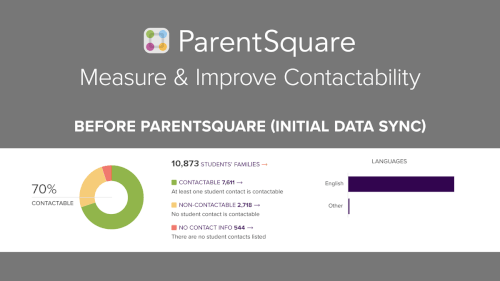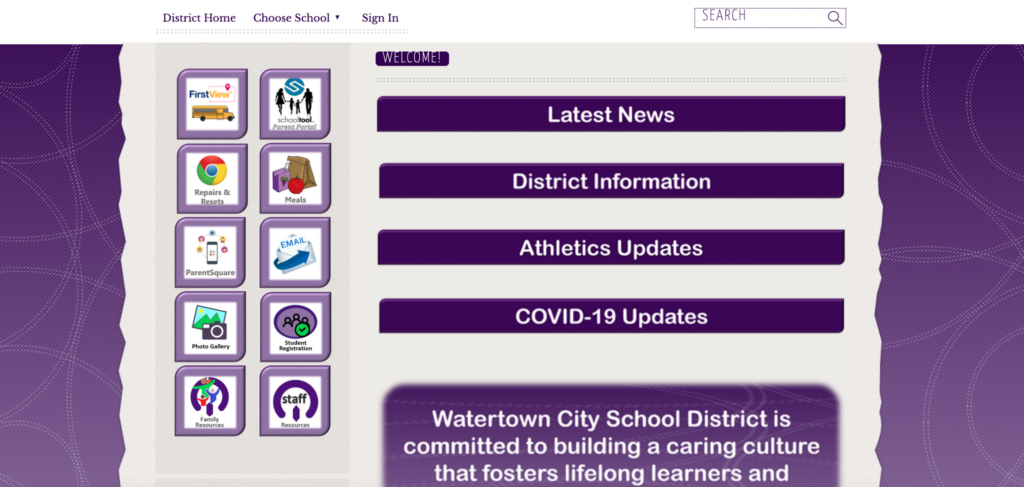
How can you support great school-home communications across your district?
As we venture into 2021 with continued COVID-19 limitations in place, how can you re-imagine and improve your school-home communications?
In our recent ParentSquare Learning Network webinar, Watertown CSD: Strategies for Great School-Home Communications, Stacey Eger-Converse, Assistant Superintendent for Curriculum and Instruction, and Lisa Blank, Director of STEM Programs for Watertown City School District provided some great ideas as they shared specific communications challenges their district faced, how they overcame them, and where their district is headed next.
Here are 6 takeaways from Watertown CSD that we think will help any district.
1. Multiple Modes of Communication Does Not Guarantee Effectiveness
“The single biggest problem in communications is the illusion that it has taken place.”
– George Bernard Shaw
Like many districts, Watertown CSD used various platforms such as social media, website, newsletter, email, and more to communicate important information to its community. However, after several district surveys returned a resounding sentiment of : “We know you’re trying, but you’re not communicating very well”, they knew it was time to rethink their communication strategy.
While Watertown CSD had all the elements of a seemingly effective communications presence, on-going changes from the pandemic left the district exhausted trying to keep up with the various modes of school-home communications. That’s when it became apparent that the district needed to adopt a unified communications platform to address the ever-changing regulations and nuances with state and local-level agencies to ensure students, families, and staff got the right information.
2. Owning Data and Its Cleanliness is Critical

School to home contactability is directly impacted by a district’s student data, so while some districts have a multitude of people working on student data, it’s not always the best solution in terms of ensuring data cleanliness and accuracy.
Watertown CSD explained that they learned districts must be discerning with who has access to data, in order to maintain a clean, unified communications approach. While collaborative efforts can be highly effective on some projects, when it comes to student data and keeping it clean, it’s best to have a limited number of people working on data input and extraction.
3. It’s Not Just What You Communicate, It’s How You Communicate
Instead of continuing to approach its communications in a piecemeal fashion, Watertown CSD committed to being more strategic in how it addresses the “what” before sending out correspondence. Watertown explained that in the past they would opt to post on their official social media accounts, but weren’t entirely certain messaging was reaching everyone.
“What needs to be communicated and how do we do it best? What’s the best mode of communication?”
Nowadays, before communicating with their audiences, they ask themselves: “What needs to be communicated and how do we do it best? What’s the best mode of communication?” Taking the time to ask these simple questions, offers the district clarity before acting.
4. Leveraging Community Partnerships and Local Media Can Be A Powerful Communications Tool
Watertown CSD routinely leverages its community partnerships and media connections to notify families of pertinent district information. With connections to the local YMCA, 4-H, and more, Watertown can rely on outside sources to get information to its families as well.
Most notably, Watertown CSD partnered with its local ABC affiliate station to let families know what reentering school would look like with COVID-19 protocol in place. A reporter attended an on-site walk through of all the measures the district was taking to ensure the safety of its students as they returned to school this fall and secured a great news story.
With the education landscape in near constant flux over the past year, positive news coverage can be difficult to come by. However, Watertown provided great tips on how they garnered media coverage and you can, too.
Community Ties to Local Media Are Invaluable
One of the reporters Watertown CSD worked with was a former student, while another reporter was a parent of a student. Identifying these connections and using them are key to getting positive news coverage. What connections might your district or school have already that you can reach out to?
Administration Buy-in Is Essential
Watertown explained that Superintendent Patricia LaBarr’s enthusiasm and support of local media helps drive the district towards newsworthy coverage. Ensuring key stakeholders are on-board, excited, and willing to serve as a spokesperson if needed is a critical step towards news coverage.
In what ways can you help administration support your media efforts? It might be through media training, getting to know your local reporters and writers, or pitching the media a great news story they simply cannot pass up!
Give Media the Inside Scoop
Before Watertown secured the ABC affiliate coverage mentioned above, the district first put together a series of videos for students and parents on how back to school would look. They filmed volunteer students taking the bus, going to class, and more, and they invited the media to watch.
Giving the media an inside scoop or simply inviting them into your community is a great way to show appreciation of their industry, build real, lasting relationships, and show them what your district (or school) is all about.
5. Make it Easy For Parents to Use Technology
Watertown CSD prides itself on its easy-to-navigate website and employs the “three-click philosophy”, meaning a user should be just three clicks away from the information they need. Their website also features easily recognizable icons and specific resource areas for staff and students.

While the district makes obtaining information easy, it also recognizes that not all parents and guardians of students are computer savvy. For example, Watertown CSD identified that a particular parent was not submitting their child’s daily COVID-19 screening online. After completing a home visit with a district technology integration specialist, the district learned this particular parent had never used a computer before.
Being able to assist parents and guardians in their efforts to engage with their child’s school through technology is another way districts can close the technology gap and make education more equitable.
6. Districts Must Be Willing to Be A Student of Their Community and Listen to Its Social Emotional Needs
A pillar of Watertown CSD’s communications efforts is making sure everyone in their district feels they’re valued, no one is left out, and students don’t miss out on opportunities. The district does this by being a student of their own community, carefully listening to its social emotional needs, and providing accordingly.
As well as regularly sharing info on meal pick up and community resources via social media, during the entire holiday season they ran Spirit Days at their school and showcased staff and student photos. Giving the families a way to see their students at school helped maintain connections, even in times where parents are unable to visit campus and engage with staff or teachers.

Another poignant example of being a student of their community is when Stacey Eger-Converse, Assistant Superintendent for Curriculum and Instruction, explained that a student had a parent who worked a night shift and couldn’t be up in the mornings to help their child get to school on-time. The district met with the family to explore how they could help the student get to school in time for class, and all parties agreed that an alarm clock was the perfect solution. The district immediately provided one to the student, which yielded great results. Watertown CSD’s continued focus on listening to community needs and being supportive, not punitive has made a positive impact on everyone.
It’s clear that Watertown CSD views school communications as the basis of a healthy school culture. Not only does the administration recognize the importance of its communications, but it also finds joy and success in communicating with its students and their families effectively.
Once it identified the need for better communications, the district was able to implement them and see the payoff almost immediately. Watertown CSD also finds that during this time of isolation, they have had increased collaboration around communications efforts with the school community. Throughout their communications journey, the district has built new connections and developed a true sense of strategy and teamwork. They serve as a wonderful template and inspiration for other school communities on what effective school-home communication looks like.
We thank Stacey Eger-Converse and Lisa Blank of the Watertown City School District for taking the time to share their story and insight. We also thank our webinar moderator and Director of Community for the ParentSquare Learning Network, Rachelle Dene Poth.







